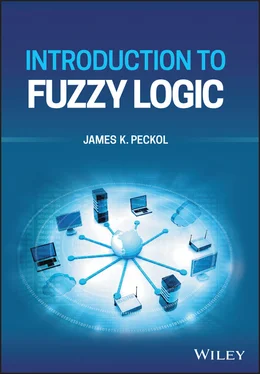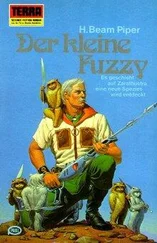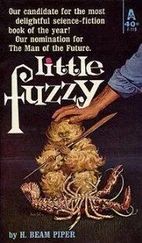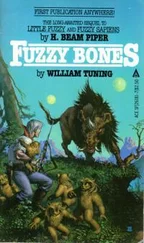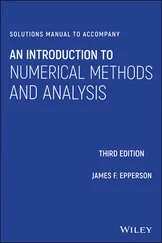James K. Peckol - Introduction to Fuzzy Logic
Здесь есть возможность читать онлайн «James K. Peckol - Introduction to Fuzzy Logic» — ознакомительный отрывок электронной книги совершенно бесплатно, а после прочтения отрывка купить полную версию. В некоторых случаях можно слушать аудио, скачать через торрент в формате fb2 и присутствует краткое содержание. Жанр: unrecognised, на английском языке. Описание произведения, (предисловие) а так же отзывы посетителей доступны на портале библиотеки ЛибКат.
- Название:Introduction to Fuzzy Logic
- Автор:
- Жанр:
- Год:неизвестен
- ISBN:нет данных
- Рейтинг книги:4 / 5. Голосов: 1
-
Избранное:Добавить в избранное
- Отзывы:
-
Ваша оценка:
- 80
- 1
- 2
- 3
- 4
- 5
Introduction to Fuzzy Logic: краткое содержание, описание и аннотация
Предлагаем к чтению аннотацию, описание, краткое содержание или предисловие (зависит от того, что написал сам автор книги «Introduction to Fuzzy Logic»). Если вы не нашли необходимую информацию о книге — напишите в комментариях, мы постараемся отыскать её.
Learn more about the history, foundations, and applications of fuzzy logic in this comprehensive resource by an academic leader Introduction to Fuzzy Logic
Introduction to Fuzzy Logic
Introduction to Fuzzy Logic
Introduction to Fuzzy Logic — читать онлайн ознакомительный отрывок
Ниже представлен текст книги, разбитый по страницам. Система сохранения места последней прочитанной страницы, позволяет с удобством читать онлайн бесплатно книгу «Introduction to Fuzzy Logic», без необходимости каждый раз заново искать на чём Вы остановились. Поставьте закладку, и сможете в любой момент перейти на страницу, на которой закончили чтение.
Интервал:
Закладка:
5 Chapter 5Figure 5.1 Evolution of language.Figure 5.2 Simple communication.Figure 5.3 Complex communication.Figure 5.4 No communication.Figure 5.5 Set membership.Figure 5.6 Subset membership.Figure 5.7 Boolean union/OR.Figure 5.8 Boolean intersection/AND.Figure 5.9 The variable number.Figure 5.10 Subsets of the set number.Figure 5.11 Fuzzy set.Figure 5.12 Graph of red color linguistic variable.Figure 5.13 Tall membership function.Figure 5.14 Tall and very tall membership functions.Figure 5.15 Tall and more or less tall membership functions.
6 Chapter 6Figure 6.1 Membership function graph for resistor size.Figure 6.2 Membership function for wine Quality vs. Aging.Figure 6.3 Entailment and containment.Figure 6.4 Set, subset, member hierarchy.Figure 6.5 Entailment and containment.Figure 6.6 A union.Figure 6.7 Not a union.Figure 6.8 The union of two fuzzy subsets.Figure 6.9 Intersection of two fuzzy subsets.Figure 6.10 Universe of discourse S.Figure 6.11 Basic universe of discourse S.Figure 6.12 Membership function for transistor leakage.Figure 6.13 Cartesian cross product A × B.Figure 6.14 Conditioned fuzzy subsets.Figure 6.15 Applying Relation R to Set X.Figure 6.16 MAX‐MIN composition of a fuzzy subset and a fuzzy relation.Figure 6.17 MAX‐MIN composition of two fuzzy subsets.Figure 6.18 Max‐product composition of two fuzzy subsets.Figure 6.19 Approximately Equal over a Set.
7 Chapter 7Figure 7.1 A simplified fuzzy system.Figure 7.2 Possible membership values in a crisp logic system.Figure 7.3 Possible membership values in a fuzzy logic system.Figure 7.4 Membership functions.Figure 7.5 Velocity degree of membership.Figure 7.6 Trapezoidal membership function.Figure 7.7 Membership function features.Figure 7.8 Fuzzy system – high‐level viewFigure 7.9 Mamdani's implication function.Figure 7.10 Larsen's implication function.Figure 7.11 Winter driving dilemma.Figure 7.12 Winter driving dilemma continued.Figure 7.13 Winter driving dilemma continued max criterion defuzzification....Figure 7.14 Winter driving dilemma continued mean of maximum criterion defuz...Figure 7.15 Winter driving dilemma continued center of gravity defuzzificati...Figure 7.16 Grand prix driver dilemma.Figure 7.17 A simplified controller system.Figure 7.18 A temperature controller block diagram.Figure 7.19 Traditional temperature control membership function.Figure 7.20 A temperature controller block diagram.Figure 7.21 Temperature control membership functions.Figure 7.22 Temperature control membership functions.Figure 7.23 Queuing and delay at a turnstile.Figure 7.24 Membership functions.Figure 7.25 Output distribution.Figure 7.26 Block diagram – automatic transmission design.Figure 7.27 Membership functions.Figure 7.28 Gear selection.Figure 7.29 Block diagram – automatic transmission design.
8 Chapter 8Figure 8.1 System model – high level external view.Figure 8.2 A simplified fuzzy system.
9 Chapter 9Figure 9.1 Threshold logic gate.Figure 9.2 Threshold gate disguised as an AND gate.Figure 9.3 Threshold gate disguised as an OR gate.Figure 9.4 Classic logic diagram.Figure 9.5 Logical function.Figure 9.6 Threshold gate final diagram.Figure 9.7 Basic combinational logic circuits.
10 Chapter 10Figure 10.1 Basic threshold device.Figure 10.2 High‐level basic neuron schematic.Figure 10.3 Basic artificial neuron schematic.Figure 10.4 AND, OR, NOT, NOR, inhibit gate configurations.Figure 10.5 AND, OR, NOT, NOR, INHIBIT weighted gate configurations.Figure 10.6 Simple McCulloch–Pitts neuron network.Figure 10.7 Basic perceptron schematic.Figure 10.8 Single and multi‐layer perceptrons.Figure 10.9 Basic perceptron models with and without bias.Figure 10.10 Linear activation function effect of a threshold signal.Figure 10.11 Linear.Figure 10.12 Threshold.Figure 10.13 Unit step.Figure 10.14 Piecewise linear.Figure 10.15 ReLU.Figure 10.16 Single‐neuron system schematic.Figure 10.17 Closed‐loop feedback control system.Figure 10.18 Perceptron weight layer.Figure 10.19 Summed input signals.Figure 10.20 Activation function.Figure 10.21 Feedback support.
11 Appendix AFigure A.1 The system and its environment.Figure A.2 The interface between the customer and the design process.Figure A.3 The system and its environment – Step 0.Figure A.4 The system and its environment – Step 1.Figure A.5 Refining the system specificationFigure A.6 The system and Its environment – Step 2.Figure A.7 The system as an aggregation of componentsFigure A.8 The customer, the requirements, the design, and the engineer.
12 Appendix BFigure B.1 The UML use case diagram.Figure B.2 Use case diagram for a simple data acquisition system.Figure B.3 Writing a use case description.Figure B.4 Class diagram.Figure B.5 UML inheritance diagram.Figure B.6 Representing an interface.Figure B.7 Representing the aggregation relationship.Figure B.8 Representing the composition relationship.Figure B.9 The call and return interaction diagram.Figure B.10 The create and destroy interaction diagram.Figure B.11 The send interaction diagram.Figure B.12 Principal components of the UML sequence diagram.Figure B.13 Sequence diagram for making a time interval measurement.Figure B.14 UML fork and join diagram..Figure B.15 UML branch and merge diagram.Figure B.16 UML activity diagram.Figure B.17 UML events.Figure B.18 Possible transitions in an UML state chart.Figure B.19 Transitions with guard conditions in a UML state chart.Figure B.20 Composite states in a UML state chartFigure B.21 Expressing a history substate in a UML state chart.Figure B.22 Expressing concurrent substates in a UML state chart.Figure B.23 Expressing a data source or sink.Figure B.24 Expressing a data store.Figure B.25 Capturing the data and control flow in an imaging system.Figure B.26 A hierarchical data and control flow diagram in an input/output ...Figure B.27 Building a basic eye diagram.Figure B.28 A basic eye diagram.Figure B.29 Signal aperture time.
Guide
1 Cover Page
2 Title Page
3 Copyright Page
4 Dedication Page
5 Preface
6 Acknowledgments
7 About the Author
8 Introduction
9 Table of Contents
10 Begin Reading
11 Appendix A Requirements and Design Specification
12 Appendix B Introduction to UML and Thinking Test
13 Bibliography
14 Index
15 Wiley End User License Agreement
Pages
1 iii
2 iv
3 v
4 xiii
5 xiv
6 xv
7 xvi
8 xvii
9 xviii
10 xix
11 xx
12 xxi
13 xxiii
14 xxv
15 xxvi
16 xxvii
17 xxviii
18 xxix
19 xxx
20 xxxi
21 1
22 2
23 3
24 4
25 5
26 6
27 7
28 8
29 9
30 10
31 11
32 12
33 13
34 14
35 15
36 16
37 17
38 19
39 20
40 21
41 22
42 23
43 24
44 25
45 26
46 27
47 28
48 29
49 30
50 31
51 32
52 33
53 34
54 35
55 36
56 37
57 38
58 39
59 40
60 41
61 43
62 44
63 45
64 46
65 47
66 48
67 49
68 50
69 51
70 52
71 53
72 54
73 55
74 56
75 57
76 58
77 59
78 60
79 61
80 62
81 63
82 64
83 65
84 66
85 67
86 68
87 69
88 70
89 71
90 72
91 73
92 74
93 75
94 76
95 77
96 78
97 79
98 80
99 81
100 82
101 83
102 84
103 85
104 86
105 87
106 88
107 89
108 90
109 91
110 92
111 93
112 94
113 95
114 96
115 97
116 98
117 99
118 101
119 102
120 103
121 104
122 105
Читать дальшеИнтервал:
Закладка:
Похожие книги на «Introduction to Fuzzy Logic»
Представляем Вашему вниманию похожие книги на «Introduction to Fuzzy Logic» списком для выбора. Мы отобрали схожую по названию и смыслу литературу в надежде предоставить читателям больше вариантов отыскать новые, интересные, ещё непрочитанные произведения.
Обсуждение, отзывы о книге «Introduction to Fuzzy Logic» и просто собственные мнения читателей. Оставьте ваши комментарии, напишите, что Вы думаете о произведении, его смысле или главных героях. Укажите что конкретно понравилось, а что нет, и почему Вы так считаете.
